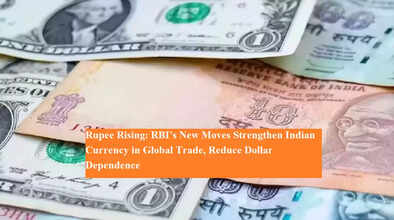Rupee Rising: RBI’s New Moves Strengthen Indian Currency in Global Trade, Reduce Dollar Dependence

India’s economic influence is expanding beyond its borders, and the Indian rupee is steadily gaining ground in international trade. The Reserve Bank of India (RBI) has recently introduced three major policy measures aimed at increasing the use of the Indian rupee in global transactions, thereby reducing the nation’s reliance on the US dollar. These strategic steps are expected to give India’s monetary system greater resilience while boosting confidence among global traders.
RBI’s Strategic Push for Rupee in Global Trade
During the RBI’s latest three-day Monetary Policy Committee (MPC) meeting, Governor Sanjay Malhotra outlined a new framework to enhance the global stature of the Indian currency. The key focus is to make cross-border trade more transparent and convenient for Indian and foreign businesses alike.
1. Transparent Exchange Rate System
The first major move involves setting transparent reference rates for currencies of India’s major trading partners. By introducing a clear and reliable benchmark for exchange rates, the RBI aims to make rupee-based transactions more trustworthy. This will encourage exporters and importers to settle their trade directly in rupees instead of converting to the dollar, saving both time and cost while boosting liquidity in the Indian currency.
2. Expansion of Special Rupee Vostro Accounts (SRVA)
The second step focuses on promoting Special Rupee Vostro Accounts (SRVA) — a mechanism that allows foreign banks to hold rupees in Indian banks for trade settlements. This system enables foreign financial institutions to carry out direct rupee transactions without relying on the US dollar as an intermediary.
With SRVA in place, more countries can now trade with India using the rupee, making transactions smoother and reducing currency conversion risks. It also protects India’s economy from global exchange rate volatility and potential currency crises, thereby reinforcing financial stability.
3. Rupee Loans for Neighboring Nations
The third key decision allows authorized Indian banks to extend rupee-denominated loans to the citizens and businesses of neighboring countries such as Bhutan, Nepal, and Sri Lanka. This initiative not only deepens India’s bilateral economic relationships but also increases the rupee’s circulation beyond national borders. It’s a strategic move that can gradually position the Indian rupee as a preferred regional currency in South Asia.
Economic Impact and Global Outlook
Experts believe that these measures will have a direct impact on India’s current account deficit (CAD) and overall monetary stability. With lower dependency on foreign currencies, India’s external sector will be less vulnerable to global shocks. This, in turn, will help maintain exchange rate stability and protect the value of the rupee.
According to RBI projections, India’s external sector is now stronger than ever. Governor Sanjay Malhotra also raised the country’s GDP growth forecast from 6.5% to 6.8%, citing steady domestic demand, rising exports, and resilient financial institutions. Meanwhile, inflation is expected to remain within the comfortable range of 2.6% to 4.5% over the upcoming quarters.
Strengthening India’s Global Financial Identity
The RBI’s latest measures are not merely technical adjustments; they represent a broader vision for India’s financial sovereignty. By empowering Indian traders to transact in rupees and extending rupee-based financial systems to partner countries, the RBI is taking a significant step toward building a “Global Rupee Ecosystem.”
Economists note that a stronger presence of the Indian rupee in international markets could pave the way for currency diversification in global trade. Over time, this could challenge the dollar-dominated system and give developing economies more flexibility in cross-border trade.
In essence, the RBI’s new strategy underscores India’s ambition to emerge as a financially independent, globally integrated economy. As the rupee’s credibility rises and more countries embrace rupee-based transactions, India is positioning itself as a central player in shaping the future of global trade dynamics.

